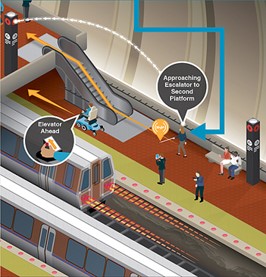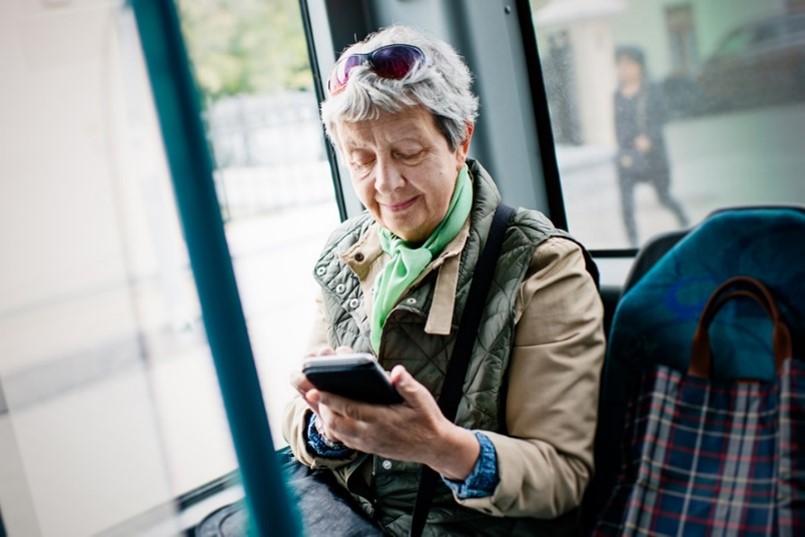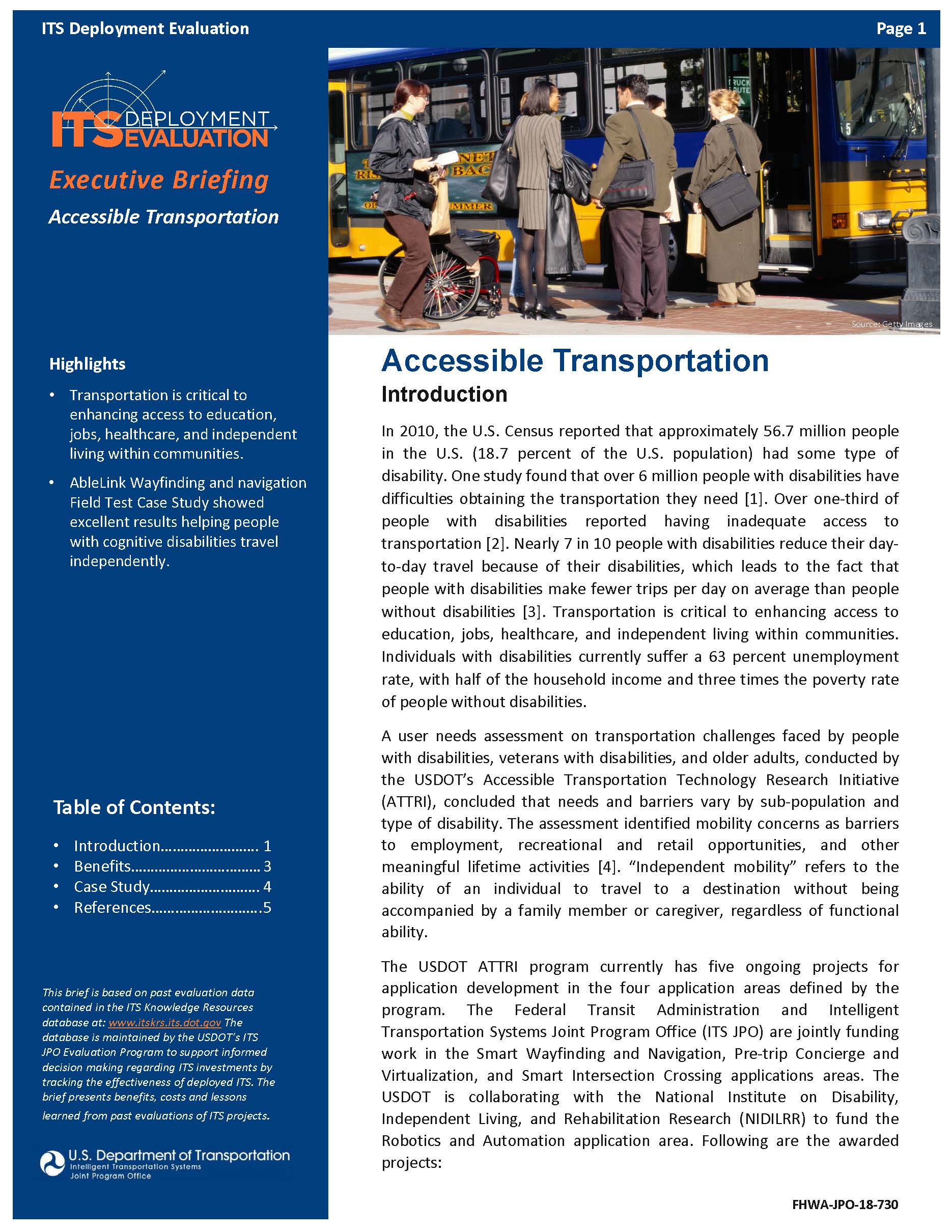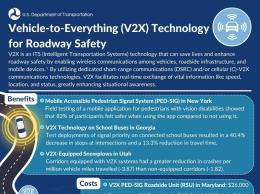Accessible Transportation (2019 Update)
2019 Executive Briefing
BRIEFING HIGHLIGHTS:
- Transportation is critical to enhancing access to education, jobs, healthcare, and independent living within communities.
- AbleLinkWayfinding and navigation Field Test Case Study showed excellent results helping people with cognitive disabilities travel independently.
Introduction
In 2010, the U.S. Census reported that approximately 56.7 million people in the U.S. (18.7 percent of the U.S. population) had some type of disability. One study found that over 6 million people with disabilities have difficulties obtaining the transportation they need [1]. Over one-third of people with disabilities; reported having inadequate access to transportation [2]. Nearly 7 in 10 people with disabilities reduce their day- to-day travel because of their disabilities, which leads to the fact that people with disabilities make fewer trips per day on average than people without disabilities [3]. Transportation is critical to enhancing access to education, jobs, healthcare, and independent living within communities. Individuals with disabilities currently suffer a 63 percent unemployment rate, with half of the household income and three times the poverty rate of people without disabilities.
A user needs assessment on transportation challenges faced by people with disabilities, veterans with disabilities, and older adults, conducted by the USDOT’s Accessible Transportation Technology Research Initiative (ATTRI), concluded that needs and barriers vary by sub-population and type of disability. The assessment identified mobility concerns as barriers to employment, recreational and retail opportunities, and other meaningful lifetime activities [4]. “Independent mobility” refers to the ability of an individual to travel to a destination without being accompanied by a family member or caregiver, regardless of functional ability.

The USDOT ATTRI program currently has five ongoing projects for application development in the four application areas defined by the program. The Federal Transit Administration and; Intelligent Transportation Systems Joint Program Office (ITS JPO) are jointly funding work in the Smart Wayfinding and Navigation, Pre-trip Concierge and Virtualization, and Smart Intersection Crossing applications areas. The USDOT is collaborating with the National Institute on Disability, Independent Living, and Rehabilitation Research (NIDILRR) to fund the Robotics and Automation application area. Following are the awarded projects:
Wayfinding and Navigation
- AbleLink –An open wayfinding media standard and related infrastructure to create geographically-specific, cloud-based libraries of routes in metropolitan or rural areas.
- Pathways Solutions –A wayfinding tool for wheelchair users and people with visual impairment that guides users along routes tailored to their preferences.
- TRX Systems –A smart wayfinding and navigation system to obtain real-time location, en-route assistance, and situational awareness.
Pre-Trip Concierge and Visualization
- AbleLink –A suite of assessment, self-directed learning, and trip execution technologies to support pre-trip planning for individuals with cognitive disabilities.
Safe Intersection Crossing
- Carnegie Mellon University –A tool to connect pedestrians with disabilities to the traffic signal systems infrastructure (and nearby connected vehicles and infrastructure) and create situational awareness to improve the safety of intersection crossing and increase independent mobility.
Robotics and Automation
- Carnegie Mellon University –This project researches and develops seamless transportation assistance from cloud-based autonomy and shared robots located in and around transportation hubs.

As the ATTRI projects develop their technologies and provide demonstrations, the USDOT will perform detailed evaluations for each project and make the evaluation results available in the ITS Knowledge Resources database.
While these technologies are currently in the development stage, the ITS Knowledge Resources databases contain several examples of the application of advanced technology to improve mobility of people with disabilities. Many of these transportation projects are focused on providing information in different formats (audio, visual, and haptic), as well as using shared used mobility solutions enabled by smartphone technology to increase access to paratransit.
Benefits
| The average passenger waiting time for users who did not have the notification system was 20.3 minutes, compared to the waiting time of stem users of 4.3 minutes (2018-01250). |
Although the majority of ATTRI projects have yet to be fully deployed, there are many accessibility initiatives across the country that are already making transportation more accessible, and that are being recorded in the ITS Knowledge resource database. A traveler notification system deployed in Essex County and the City of Newark in New Jersey provided automated voice calls or text messages to users to alert them to the fact that their paratransit vehicles are near or almost at a prearranged pickup point.
By making use of the Google Traffic API to more accurately estimate travel time, the system was able to substantially reduce the time window of arrival times and simultaneously provide drivers with real-time route
guidance.

The deployment of this notification system was found to reduce paratransit waiting times by 15 to 20 minutes. In almost every case, the vehicles actually arrived one minute earlier than the proposed arrival time, allowing travelers’ journeys to be even more time-efficient than expected. The average passenger waiting time for users who did not have the notification system was 20.3 minutes, compared to the waiting time of notification system users of 4.3 minutes. This reduction in waiting time allows travelers to take trips with greater flexibility and ease (2018-01250).
Case Study
AbleLink Wayfinder Application: Black Hill Works
The ATTRI program’s overarching goal is to eliminate barriers facing travelers and to enable independent mobility for all Americans. The following narrative is a real success story demonstrating the difference that the AbleLink Wayfinder application has already made during field testing. The Wayfinder app was developed to help individuals with cognitive disabilities travel independently, allowing users to access and share routes that enable them to use public transportation on their own [5]. As part of the ATTRI program, AbleLink is working with the USDOT to develop the SMART Wayfinding Standard to upgrade the app’s functionality and make it even more accessible and useful to its users. In addition, the SMART standard will simplify the process of creating and sharing accessible routes, promoting the development of new wayfinding technologies and expanding overall access to transportation.
A young man of 26 lives in Rapid City, South Dakota. He lives independently with four other roommates and has a job as an assistant at a local grocery store. He has a great work ethic and getting to work on time every day is very important to him. His schedule varied a lot throughout the week, however, and his work was too far away for him to walk every day, which posed a significant problem. He did not have a driver’s license and he did not know how to use the bus system. As a result, he was fully dependent on staff for getting rides to and from work.

Staff from Black Hills Works, the local adult services agency supporting individuals with disabilities approached him and asked if he wanted to learn to ride the bus on his own to get to work. Although hesitant, he agreed to try and learn how to ride the bus. Unfortunately, the day he was scheduled to learn to ride, the trainer was late and there was confusion over which route and destination were to be trained.
Both of these factors resulted in him feeling significant stress, caused the effort to teach him how to ride the bus to and from work to be unsuccessful. He returned to receiving rides from other staff to get to and from work, which could be complex and stressful to coordinate for both him and his coworkers.
Then, Black Hills Works began to work with WayFinder, AbleLink’s cognitively accessible transportation app that has been recently modified to work with the SMART Wayfinding Standard toolset developed through funding from ATTRI. The young man was once again asked if he would like to try to learn to ride the bus—and this time Black Hills Works staff began using WayFinder as a support tool.
| “After two ride-alongs, he announced ‘OK, I don’t need you anymore!’ From that day on, he began successfully travelling to work completely on his own, using WayFinder to guide him along the way.” |
They created two new WayFinder routes containing multimedia step-by-step instructions for him: one to travel to work and one to travel back home. The Black Hills Work staff then set up a bus-riding schedule to show him how to use WayFinder to travel on the bus. After two ride-alongs, he announced “OK, I don’t need you anymore!” From that day on, he began successfully travelling to work completely on his own, using WayFinder to guide him along the way.
Immediately, his self-confidence skyrocketed, and he no longer had to make multiple calls to the store office each day for rides and ETA updates. After experiencing the newfound freedom of unrestricted travel, he asked staff how he could learn new bus routes around town. Black Hills Work staff provided him with the bus route schedules for RTS, Rapid City’s Rapid Transit System, and he was able to learn new routes on his own. Not long after this, he announced to staff he no longer needed WayFinder. They were then able to provide the device to another who needed help riding the bus, fully customized with new routes created for that individual.
The young man’s use of WayFinder and the experience he gained traveling the bus to and from work resulted in such an increase in confidence that he began exploring the city on his own: Instead of travelling only for work, he began taking the bus to go to stores and to see friends. His freedom allowed him to go to work early to meet up with co-workers for lunch at the café, and, as a result, his social network grew.
| “After experiencing freedom of travel, his personality has blossomed, and he has become far more outgoing with all kinds of confidence!” |
The Director of Innovation and Assistive Technology at Black Hills Works commented that the young man “had never expressed to staff that he had a desire for any of these social outings or additional travel destinations. But after experiencing freedom of travel, his personality has blossomed, and he has become far more outgoing with all kinds of confidence! And not having to answer repeated calls from wondering about his ride has been a great benefit to staff as well.” Cognitively accessible mobile technologies are changing lives for many individuals and are enabling newfound freedoms and opportunities, leading to an increase in the overall quality of life.
References
- "Transportation Difficulties Keep Over Half a Million Disabled at Home." Issue Brief, USDOT Bureau of Transportation Statistics, 2003. https://www.bts.gov/archive/publications/special_reports_and_issue_briefs/issue_briefs/number_03/entire.
- "The ADA, 20 Years Later." Kessler Foundation/NOD Survey of Americans With Disabilities, 2010. https://www.socalgrantmakers.org/sites/default/files/resources/Suvery%20of%20Americans%20with%20 Disabilities.pdf.
- "Travel Patterns of American Adults with Disabilities." Issue Brief, USDOT Bureau of Transportation Statistics, 2018. https://www.bts.gov/travel- patterns-with-disabilities.
- Accessible Transportation Technologies Research Initiative (ATTRI), User Needs Assessment Report, USDOT, May 2016, FHWA-JPO-16-354. https://rosap.ntl.bts.gov/view/dot/31320.
- Accessible Transportation Technologies Research Initiative: Wayfinding & Navigation. USDOT, https://www.its.dot.gov/research_areas/attri/wayfinding_nav.htm.


